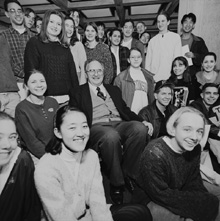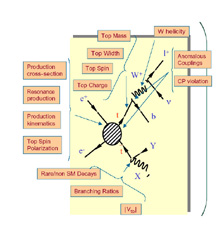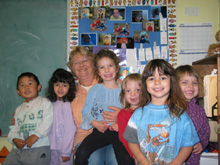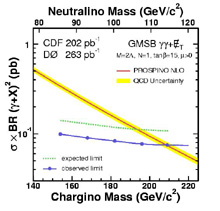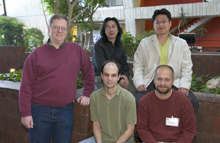 | Friday, May 6, 2005 |
|
Friday, May 6 3:30 p.m. DIRECTOR'S COFFEE BREAK - 2nd Flr X-Over 4:00 p.m. Joint Experimental Theoretical Physics Seminar - 1 West Speaker: V. Khoze, University of Durham Title: Central Exclusive Production of Higgs Bosons and Other States 8:00 p.m. Fermilab International Film Society - Auditorium Tickets: Adults $4 Title: Uzak (Distant)
Saturday, May 7
Monday, May 9 |
|
Extended Forecast |
Secon Level 3 |
|
Friday, May 6 Beef Pepper Pot Buffalo Chicken Wings $4.75 Cajun Breaded Catfish $3.75 Sweet & Sour Pork Over Rice $3.75 Honey Mustard Ham & Swiss Panini $4.75 Double Stuffed Pizza $3.75 Carved Turkey $4.75 The Wilson Hall Cafe now accepts Visa, Master Card, Discover and American Express at Cash Register #1.
Wilson Hall Cafe Menu |
| Fermilab Today is online at: http://www.fnal.gov/today/ Send comments and suggestions to today@fnal.gov Fermilab Today archive Fermilab Today PDF Version Fermilab Result of the Week archive Fermilab Safety Tip of the Week archive Linear Collider News archive Fermilab Today classifieds Subscribe/Unsubscribe to |
|
Fermilab's Saturday Morning Physics Program Marks
25th Anniversary at Graduation Ceremonies on May 14, 2005 | ||
| ||
|
In 1979, then-Director Leon Lederman of the Department of Energy's Fermi National Accelerator Laboratory decided he wanted to do some teaching again, to regain the contact with young minds he had enjoyed as a professor at Columbia University. The resulting Saturday Morning Physics program at Fermilab has spread immeasurable benefits among some 6,000 high school-aged students over the past 25 years.
Saturday Morning Physics, founded by Lederman and physicist colleague Drasko Jovanovic, celebrates its 25th anniversary on Saturday, May 14, 2005 when the current class graduates at 11 a.m. in the One West conference room of Fermilab's Wilson Hall. Media representatives are invited to attend. Jovanovic directed the program until his retirement in 1997. Roger Dixon, Head of Fermilab's Accelerator Division, and Erik Ramberg, Test Beam Coordinator for Experimental Physics Projects, have worked as co-directors since then.
|
|
What's Up with the ILC? Top as the Gateway to New Physics | ||
| ||
|
The top quark is the heaviest elementary particle known. It weighs as much as
an entire gold atom, but yet its size is much smaller than a proton, and
theorists treat it as a point-like structure. Because of its unique properties
the top quark provides a great opportunity to study the fundamental parameters
of particles and forces and to look for deviations from the Standard Model.
Ultimately, scientists hope that the top quark will shed light on what is known
as electroweak symmetry breaking, the mechanism that explains why photons
are massless while the Z and W bosons have mass. The Standard Model predicts
a single Higgs boson to cause the symmetry breaking, but alternatives exist.
"Many other theoretical models predict modifications to the couplings between top and electroweak gauge bosons," explained Fermilab's Aurelio Juste during his ILC presentation on top quark research last Wednesday. He is one of the leaders of the Top/QCD Working Group of the American Linear Collider Physics Group. Together with corresponding groups in Europe and Asia, the American Top/QCD group tries to determine how the ILC can unveil these new interactions in different ways than the LHC. "The polarization of the ILC beams is an important tool." The ILC will produce about 200,000 top quark pairs per year in a "clean" environment. At hadron colliders such as the Tevatron or the LHC, top quark-producing collisions lead to a large amount of "particle debris" that interferes with precise measurements. This noise is mostly absent in the electron-positron collisions of the ILC. But Juste cautioned his colleagues and reminded them of the challenges that an ILC detector must meet. "Life is not that easy even within the environment of a linear collider," he said. To meet the physics goals, the detector must have precision vertexing; precision global tracking; and optimal calorimetry that connects energy measurements one-to-one with observed particle tracks. With the right equipment, the ILC detector may even record rare top quark decays that are not allowed or are highly suppressed by the SM. "Observation of such decays would be a clear indication of new physics," Juste said.
Fermilab's ILC Web site provides a link to the slides of Juste's presentation.
The Top/QCD and all other working groups of the American Linear Collider
Physics Group will meet at Snowmass
from August 14 to 27.
|
|
Spirit of Collaboration | ||
| ||
|
Experimental High Energy Physics is a competitive field. The spirit
of competition helps collaborations make detectors operate more
efficiently and produce higher quality analyses faster. But the ultimate
goal of physicists is to learn about the world we live in. That's why
members of the CDF and DZero collaborations get together to combine
the measurements to improve the results.
Both experiments have recently published searches for new physics in di-photon events with large missing transverse energy (CDF and DZero). Many models predict an increased production of such events, and both experiments had seen quite unusual events (CDF and DZero). However, there is not enough evidence that these events are inconsistent with coming from Standard Model processes. While this is certainly disappointing, these searches can be used to restrict model parameter space and provide important feedback to theorists. The analysis teams in both experiments kept in touch well before the analyses were complete, making sure that the theoretical assumptions of the analyses were similar. An important model of supersymmetry (SUSY), the so-called Snowmass Slope with Gauge-Mediated SUSY breaking, was chosen to be the model of new physics to test against experimental observations. This early interaction, and invaluable help from Fermilab's Theory Division, assured that the individual results could be properly combined. Recently, the Tevatron New Phenomena Working Group made public the combined limit on the effective scale of SUSY breaking, which can be translated into the lower limit on the mass of the lightest neutralino of 114 GeV. This is the best limit on neutralino mass to date and, as expected, it is much better than individual limits from CDF and DZero. The researchers in both experiments remain hopeful that a definitive sign of new physics will be found as the Tevatron run continues. With candidate events being very rare, it is possible that only a combination of CDF and DZero results would enable a discovery. | ||
| ||
|
Result of the Week Archive |
|
Retired - Dotti Swanson, LSS, 5/6/05 |
|
From the Chicago Sun-Times, May 2, 2005 Fermilab has 250 trillion reasons to outsource data by Jim Ritter Imagine having to wade through enough information to fill a shelf of Encyclopedia Britannicas stretching from Chicago to Pittsburgh.
That's the challenge faced by physicists at Fermilab, the world's most powerful subatomic particle accelerator. Fermilab smashes together subatomic particles at nearly the speed of light in order to better understand the structure of matter and laws of nature.
|
|
Fermilab Arts Series The Arts Series presents "Hibiki: A Celebration of Japan's Musical Heritage" on May 7 at 8:00 p.m. in Ramsey Auditorium. There will be a free pre-concert talk at 7:00 p.m. Tickets are $20 ($10 ages 18 and under). more information
Fermilab Film Series
New Classifieds on Fermilab Today
Annual NALWO Spring Tea
Claim Your Bikes Outside Wilson Hall
Fermilab Folk Club Barn Dance
|
